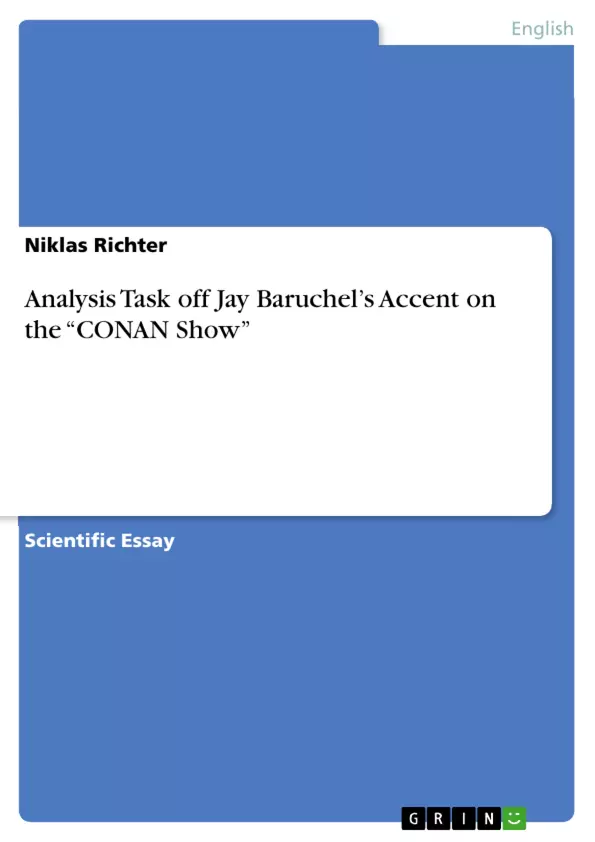The paper discusses accounts of faked accents that carry linguistic meaning.
Although many do not want to acknowledge it, it is covertly clear that every human being possesses an accent, which he/she uses in his/her day-to-day life. However, in many of those described situations, people are still asked to conceal their accent in order to reach a wider audience or to comply with the set ‘standard’ of the English language, being ‘General American’ (GenAm) and ‘Received Pronunciation’ (RP). As one can imagine, this only leads to further reinforcement of the idea that everybody’s language repertoire, concerning the choice of an accent, should be allocated to one of the two already-mentioned standardized English ‘norms’, being GenAm or RP.
To illustrate the thought process of one being demanded to adapt his accent to a more American audience as well as to simultaneously conduct my analysis on the phonological features of the Canadian Accent and to perform the register analysis, I
needed a matching sample. Therefore, I chose the example of the actor “Jay Baruchel” talking about his role of the protagonist “Hiccup Horrendous Haddock III” in How to Train Your Dragon on the talk show “Conan”, which is hosted by the comedian “Conan O’Brien” and his sidekick “Andy Richter” on the channel “TBS”.
Inhaltsverzeichnis (Table of Contents)
- Analysis Task off Jay Baruchel's Accent on the "CONAN Show"
- Introduction
- Analysis of the "Cot-Caught Merger" in Baruchel's Speech
- The Use of the Stereotypical "Eh"
- Register Analysis
- Conclusion
Zielsetzung und Themenschwerpunkte (Objectives and Key Themes)
This analysis aims to examine the phonological features of the Canadian accent as demonstrated by actor Jay Baruchel on the "CONAN Show," focusing on how he navigates the pressure to suppress his accent for a wider audience.
- The impact of accent on audience perception
- The "Cot-Caught Merger" and its implications in Canadian English
- The use of stereotypical Canadian features like "Eh"
- The role of register in conveying a message and its impact on audience engagement
- The interplay between language, identity, and performance in media contexts
Zusammenfassung der Kapitel (Chapter Summaries)
- The introduction lays out the context for the analysis, highlighting the pressure to conform to standardized English norms, particularly GenAm and RP. It establishes the example of Jay Baruchel's speech on "CONAN" as a case study for examining these pressures and analyzing the Canadian accent.
- The analysis focuses on the "Cot-Caught Merger" as a prominent feature of Canadian English, specifically examining Baruchel's pronunciation of words like "tomorrow" and "sorry". It also discusses the social significance of this merger and its implications for understanding Canadian identity.
- The chapter on "Eh" explores the history and usage of this stereotypical exclamation in Canadian English. It examines the potential reasons for its declining use, including a shift towards alternative expressions like "right" and a desire to avoid reinforcing stereotypes.
- The register analysis delves into Baruchel's use of public-informal register on "CONAN." It examines the significance of slang expressions, filler words, and discourse markers in creating a casual and relatable tone. The analysis connects these linguistic choices to Baruchel's desire to engage with his audience and build a connection with them.
Schlüsselwörter (Keywords)
This analysis focuses on the Canadian accent, the "Cot-Caught Merger," register analysis, public-informal register, discourse markers, filler words, and the use of slang. It explores the interplay between language, identity, and performance in media contexts, highlighting the pressures and complexities of navigating standardized English norms.
- Quote paper
- Niklas Richter (Author), 2019, Analysis Task off Jay Baruchel’s Accent on the “CONAN Show”, Munich, GRIN Verlag, https://www.grin.com/document/1452429



